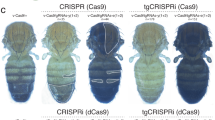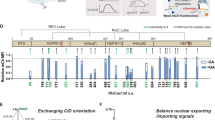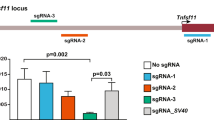Abstract
RNA interference (RNAi) has emerged as a powerful tool to downregulate the expression of specific genes. Drug-inducible systems allowing for conditional RNAi that offer the unique potential to modulate expression of virtually any endogenous gene in the cell have been recently developed. Their applications are very broad, ranging from basic studies of gene function to translational research including modeling of human diseases, analysis of potential side effects of candidate drugs, testing of gene-based therapies and loss-of-function screens. Here we summarize the state of the art of systems allowing for drug-controllable knockdown, and provide a description of their current and future applications.
This is a preview of subscription content, access via your institution
Access options
Subscribe to this journal
Receive 12 print issues and online access
$259.00 per year
only $21.58 per issue
Buy this article
- Purchase on Springer Link
- Instant access to full article PDF
Prices may be subject to local taxes which are calculated during checkout



Similar content being viewed by others
References
Elbashir, S.M. et al. Duplexes of 21-nucleotide RNAs mediate RNA interference in cultured mammalian cells. Nature 411, 494–498 (2001).
Hannon, G.J. & Rossi, J.J. Unlocking the potential of the human genome with RNA interference. Nature 431, 371–378 (2004).
Brummelkamp, T.R., Bernards, R. & Agami, R. Stable suppression of tumorigenicity by virus-mediated RNA interference. Cancer Cell 2, 243–247 (2002).
Dorsett, Y. & Tuschl, T. siRNAs: applications in functional genomics and potential as therapeutics. Nat. Rev. Drug Discov. 3, 318–329 (2004).
Zeng, Y., Cai, X. & Cullen, B.R. Use of RNA polymerase II to transcribe artificial microRNAs. Methods Enzymol. 392, 371–380 (2005).
van de Wetering, M. et al. Specific inhibition of gene expression using a stably integrated, inducible small-interfering-RNA vector. EMBO Rep. 4, 609–615 (2003).
Hoeflich, K.P. et al. Oncogenic BRAF is required for tumor growth and maintenance in melanoma models. Cancer Res. 66, 999–1006 (2006).
Ohkawa, J. & Taira, K. Control of the functional activity of an antisense RNA by a tetracycline-responsive derivative of the human U6 snRNA promoter. Hum. Gene Ther. 11, 577–585 (2000).
Chen, Y., Stamatoyannopoulos, G. & Song, C.Z. Down-regulation of CXCR4 by inducible small interfering RNA inhibits breast cancer cell invasion in vitro. Cancer Res. 63, 4801–4804 (2003).
Matsukura, S., Jones, P.A. & Takai, D. Establishment of conditional vectors for hairpin siRNA knockdowns. Nucleic Acids Res. 31, e77 (2003).
Berns, K. et al. A large-scale RNAi screen in human cells identifies new components of the p53 pathway. Nature 428, 431–437 (2004).
Ngo, V.N. et al. A loss-of-function RNA interference screen for molecular targets in cancer. Nature 441, 106–110 (2006).
Gupta, S., Schoer, R.A., Egan, J.E., Hannon, G.J. & Mittal, V. Inducible, reversible, and stable RNA interference in mammalian cells. Proc. Natl. Acad. Sci. USA 101, 1927–1932 (2004).
Amar, L., Desclaux, M., Faucon-Biguet, N., Mallet, J. & Vogel, R. Control of small inhibitory RNA levels and RNA interference by doxycycline induced activation of a minimal RNA polymerase III promoter. Nucleic Acids Res. 34, e37 (2006).
Wiznerowicz, M. & Trono, D. Conditional suppression of cellular genes: lentivirus vector-mediated drug-inducible RNA interference. J. Virol. 77, 8957–8961 (2003).
Szulc, J., Wiznerowicz, M., Sauvain, M.O., Trono, D. & Aebischer, P. A versatile tool for conditional gene expression and knockdown. Nat. Methods 3, 109–116 (2006).
Arrighi, J.F. et al. Lentivirus-mediated RNA interference of DC-SIGN expression inhibits human immunodeficiency virus transmission from dendritic cells to T cells. J. Virol. 78, 10848–10855 (2004).
Miyake, K. et al. Development of cellular models for ribosomal protein S19 (RPS19)-deficient diamond-blackfan anemia using inducible expression of siRNA against RPS19. Mol. Ther. 11, 627–637 (2005).
Toniatti, C., Bujard, H., Cortese, R. & Ciliberto, G. Gene therapy progress and prospects: transcription regulatory systems. Gene Ther. 11, 649–657 (2004).
Zeng, Y. & Cullen, B.R. Efficient processing of primary microRNA hairpins by Drosha requires flanking nonstructured RNA sequences. J. Biol. Chem. 280, 27595–27603 (2005).
Stegmeier, F., Hu, G., Rickles, R.J., Hannon, G.J. & Elledge, S.J. A lentiviral microRNA-based system for single-copy polymerase II-regulated RNA interference in mammalian cells. Proc. Natl. Acad. Sci. USA 102, 13212–13217 (2005).
Dickins, R.A. et al. Probing tumor phenotypes using stable and regulated synthetic microRNA precursors. Nat. Genet. 37, 1289–1295 (2005).
Garcia-Otin, A.L. & Guillou, F. Mammalian genome targeting using site-specific recombinases. Front. Biosci. 11, 1108–1136 (2006).
Tiscornia, G., Tergaonkar, V., Galimi, F. & Verma, I.M. CRE recombinase-inducible RNA interference mediated by lentiviral vectors. Proc. Natl. Acad. Sci. USA 101, 7347–7351 (2004).
Ventura, A. et al. Cre-lox-regulated conditional RNA interference from transgenes. Proc. Natl. Acad. Sci. USA 101, 10380–10385 (2004).
Meissner, A. & Jaenisch, R. Generation of nuclear transfer-derived pluripotent ES cells from cloned Cdx2-deficient blastocysts. Nature 439, 212–215 (2006).
Chang, H.S., Lin, C.H., Chen, Y.C. & Yu, W.C. Using siRNA technique to generate transgenic animals with spatiotemporal and conditional gene knockdown. Am. J. Pathol. 165, 1535–1541 (2004).
Li, M.J. & Rossi, J.J. Lentiviral vector delivery of recombinant small interfering RNA expression cassettes. Methods Enzymol. 392, 218–226 (2005).
Tiscornia, G., Singer, O., Ikawa, M. & Verma, I.M. A general method for gene knockdown in mice by using lentiviral vectors expressing small interfering RNA. Proc. Natl. Acad. Sci. USA 100, 1844–1848 (2003).
Zufferey, R., Nagy, D., Mandel, R.J., Naldini, L. & Trono, D. Multiply attenuated lentiviral vector achieves efficient gene delivery in vivo. Nat. Biotechnol. 15, 871–875 (1997).
Naldini, L. et al. In vivo gene delivery and stable transduction of nondividing cells by a lentiviral vector. Science 272, 263–267 (1996).
Lois, C., Hong, E.J., Pease, S., Brown, E.J. & Baltimore, D. Germline transmission and tissue-specific expression of transgenes delivered by lentiviral vectors. Science 295, 868–872 (2002).
Moffat, J. et al. A lentiviral RNAi library for human and mouse genes applied to an arrayed viral high-content screen. Cell 124, 1283–1298 (2006).
Kuninger, D. et al. Gene disruption by regulated short interfering RNA expression, using a two-adenovirus system. Hum. Gene Ther. 15, 1287–1292 (2004).
Li, L. et al. Evaluating hypoxia-inducible factor-1α as a cancer therapeutic target via inducible RNA interference in vivo. Cancer Res. 65, 7249–7258 (2005).
Matthess, Y. et al. Conditional inhibition of cancer cell proliferation by tetracycline-responsive, H1 promoter-driven silencing of PLK1. Oncogene 24, 2973–2980 (2005).
Ito, T. et al. An inducible short-hairpin RNA vector against osteopontin reduces metastatic potential of human esophageal squamous cell carcinoma in vitro and in vivo. Clin. Cancer Res. 12, 1308–1316 (2006).
Lin, X. et al. Development of a tightly regulated U6 promoter for shRNA expression. FEBS Lett. 577, 376–380 (2004).
Leenders, F. et al. PKN3 is required for malignant prostate cell growth downstream of activated PI 3-kinase. EMBO J. 23, 3303–3313 (2004).
Brown, S.A. et al. PERIOD1-associated proteins modulate the negative limb of the mammalian circadian oscillator. Science 308, 693–696 (2005).
Yu, J. & McMahon, A.P. Reproducible and inducible knockdown of gene expression in mice. Genesis 44, 252–261 (2006).
Author information
Authors and Affiliations
Corresponding author
Ethics declarations
Competing interests
M.W. and D.T. have patented some of the technologies described in this paper.
Rights and permissions
About this article
Cite this article
Wiznerowicz, M., Szulc, J. & Trono, D. Tuning silence: conditional systems for RNA interference. Nat Methods 3, 682–688 (2006). https://doi.org/10.1038/nmeth914
Published:
Issue Date:
DOI: https://doi.org/10.1038/nmeth914
This article is cited by
-
Off and back-on again: a tumor suppressor’s tale
Oncogene (2018)
-
Discovery of long-range inhibitory signaling to ensure single axon formation
Nature Communications (2017)
-
Identification of Schistosoma mansoni microRNAs
BMC Genomics (2011)
-
Inhibition of highly pathogenic PRRSV replication in MARC-145 cells by artificial microRNAs
Virology Journal (2011)
-
A bidirectional promoter architecture enhances lentiviral transgenesis in embryonic and extraembryonic stem cells
Gene Therapy (2011)



